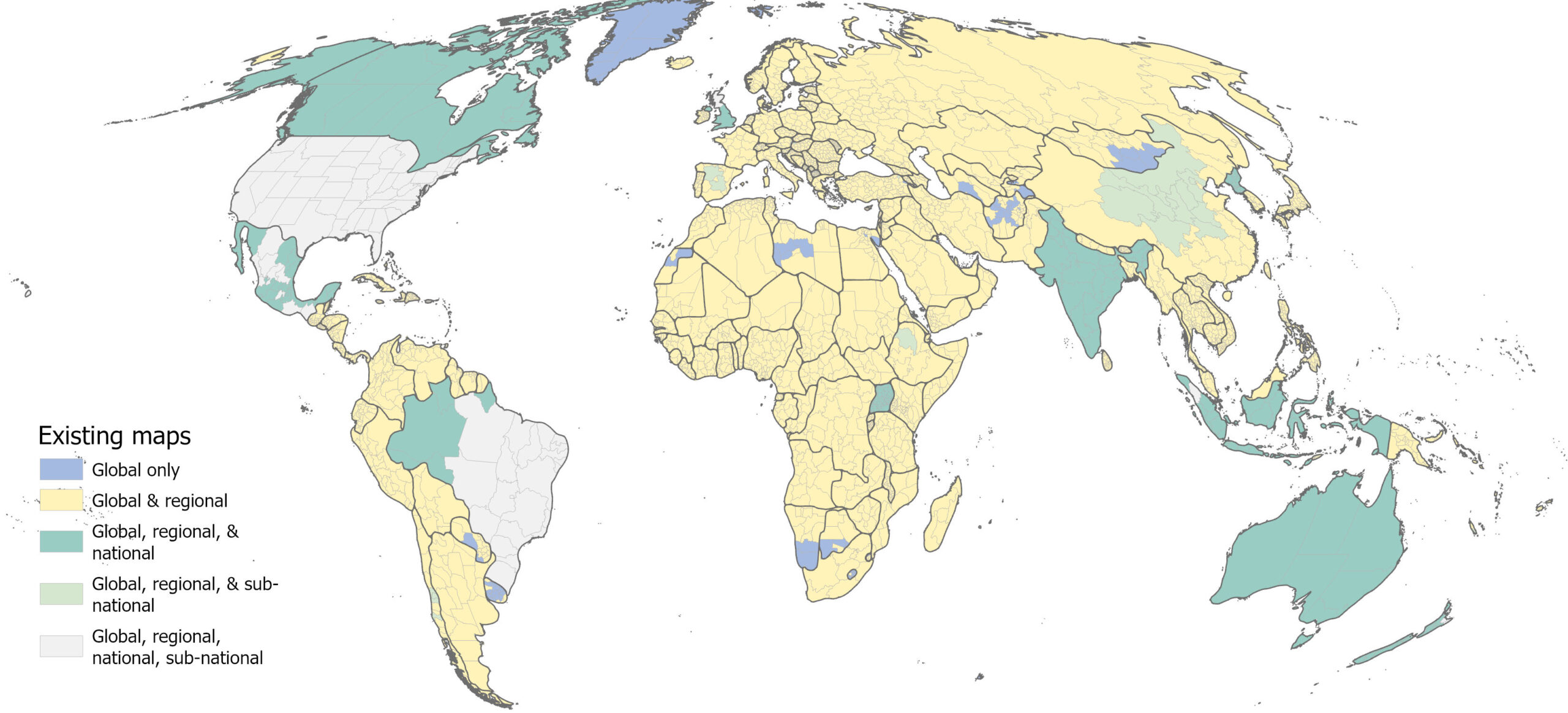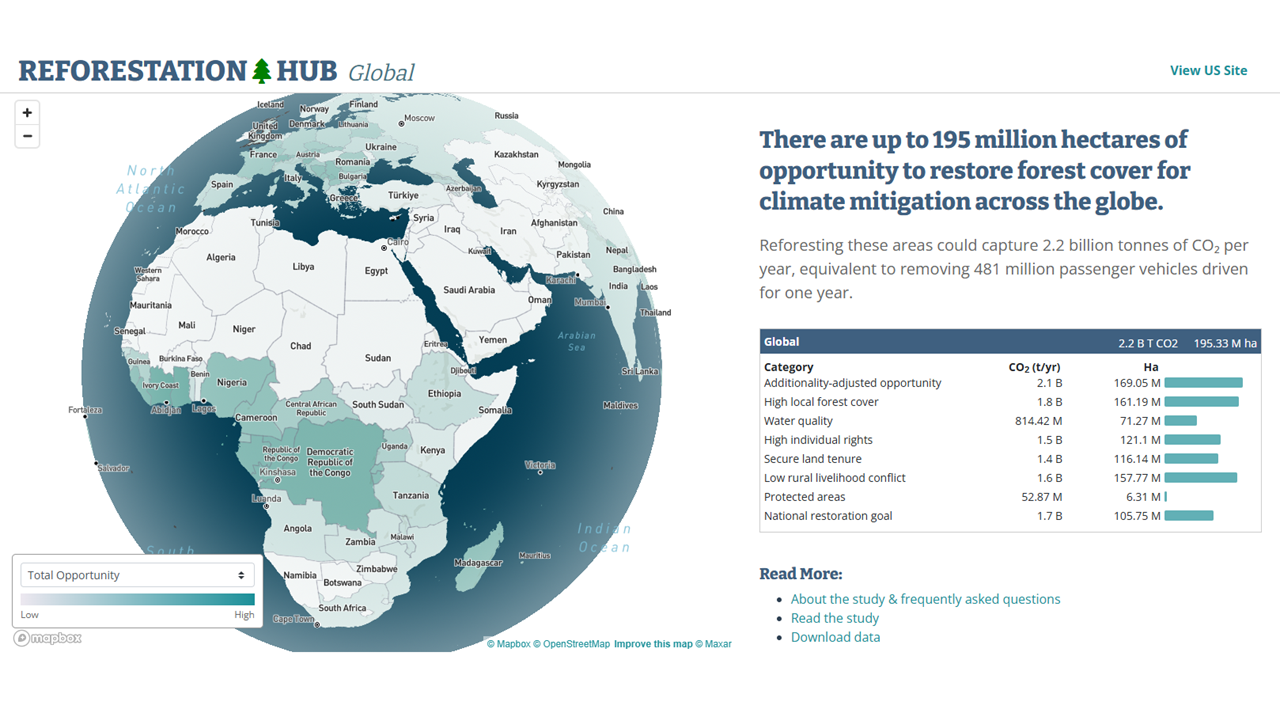Over the past decade, research has emerged suggesting that ramping up reforestation around the world could make a substantial contribution to tackling climate change.
Studies have estimated that the CO2-absorbing power of newly planted trees could add up to mitigation “potential” of 10bn tonnes (GtCO2) per year – more than the annual emissions of the US.
Achieving this would require planting trees across 678m hectares – an area twice the size of India.
But the uncertainty around those figures is large due to a range of factors, such as where sufficient trees already exist, how much climate mitigation those trees offer and where people actually want additional trees to be planted.
In our new study, published in Nature Communications, we unpack eight years of research into reducing these uncertainties.
We have quantified, for example, how the carbon-sucking power of trees changes when you let forests grow back naturally versus planting monoculture or mixed-species plantations.
We figured out how much carbon could be removed at different price points and mapped where trees – somewhat counterintuitively – actually act to warm, rather than cool, our climate.
But, as we shrank the uncertainty, we also shrank the estimate itself.
Our research provides the most precise estimate of global reforestation area to date – 195m hectares, or 71% less than earlier estimates.
Reforesting an area this size could capture 2GtCO2 per year.
Mapping reforestation opportunity
Maps of global reforestation potential have been cited in thousands of scientific publications, inspired large-scale tree-planting movements and been used by the International Panel on Climate Change (IPCC) in its flagship reports.
However, they have also been very controversial.
Critics have pointed out, for example, that these maps failed to account for natural disturbances that prevent forest growth, ignored existing trees and overlooked the people that live, steward and often depend on those lands for their wellbeing.
In our new study, we resolved to produce a map that addresses these past critiques.
We began by searching for existing maps of reforestation “opportunity”.
Our search uncovered 89 such maps, although most of those we identified are national or sub-national. Some places – such as Brazil’s Atlantic Forest – have many maps, but we found that most of the globe was only covered by a single older, more controversial map.
The map below shows where we found existing maps at the global, regional, national and sub-national levels.

Thus, we set about creating a new global map that built upon the methods of past efforts, tackled prominent critiques and incorporated newly available layers.
Our new map accounts for albedo, for example – how restoring tree cover can, in some locations, actively heat the Earth, rather than cool it, by affecting how much sunlight is absorbed or reflected.
It excludes native grasslands and other ecosystems where carpeting the land with trees would harm biodiversity and exacerbate the risk of wildfire. And it layers in additional safeguards, such as food security, to ensure that reforestation outcomes are more likely to be beneficial to people.
These constraints left us with up to 195m hectares of reforestation opportunity across the world.
A reforestation ‘menu’
Not all reforestation opportunities are created equal – different communities may want to implement reforestation for different reasons, such as restoring floodplains or re-establishing iconic ecosystems that have been lost.
So, alongside the reforestation opportunity, our map shows other factors that communities or decisionmakers may use to help them prioritise areas for reforestation.
We show, for example, where natural regeneration may be most likely to occur and where biodiversity benefits may be greatest, given proximity to existing forest. We show where reforestation opportunity exists on slopes and floodplains – and therefore is more likely to provide benefits for the local watershed. We show places where people have strong rights and secure land tenure, to avoid exacerbating social inequities.
Perhaps unsurprisingly, it is hard to find places that tick all of these complex boxes. But, it is still possible to achieve multiple objectives in one location.
In fact, our study finds that 83% of reforestation opportunities occur close to existing forest, while 81% occur in places that are expected to have low conflicts with rural livelihoods.
More than half of the opportunity that we identify also occurs in countries with explicit restoration goals – places such as Brazil’s Atlantic Forest, where we are working with local partners and communities to restore 1.2m hectares of forest. Forest restoration there contributes to national climate goals, supports sustainable economic development and connects habitat for wildlife.
Alongside the paper, we present the Global Reforestation Hub, which allows users to explore this menu of reforestation options, drill down to reforestation potential at county level and see what opportunities meet a given set of objectives.
For example, a government interested in climate mitigation and protection from floods might use the tool to find the places within their country where both goals might be achieved via reforestation.
The screenshot below shows the Global Reforestation Hub. Countries are coloured by their total reforestation opportunity, from low (white) to high (dark blue). The table shows the amount of land available for – and the CO2 mitigation potential of – reforestation given different priorities and constraints.

Smaller can be better
Reforestation remains one of the most cost-effective climate removal options, but it cannot – and should not – happen everywhere.
While there are certainly opportunities to plant and regrow trees beyond what we have mapped here, we created these maps to show where the climate mitigation opportunities – and their co-benefits – are most concentrated.
Prioritising other motivations, such as human health, habitat for specific wildlife species or local considerations, would also increase the total reforestation opportunity area. For example, our maps don’t include the potential for reforestation in dense urban areas, but trees in those areas can be highly beneficial for human health.
Our study prioritised mapping opportunities for climate change mitigation – and we were deliberately conservative, erring on the side of caution when determining which places to include.
The result is a map that shows the places where reforestation offers both the greatest climate benefits and the fewest downsides for both people and nature.
During a year when the UN climate COP will be hosted in the most iconic forest of all, our study is less a critique of the pre-existing numbers and more an effort to create the most precise and pragmatic maps of reforestation potential. This can help ensure that we get the reforestation part of the climate equation right.
The post Guest post: Why the global area for regrowing trees is 71% smaller than thought appeared first on Carbon Brief.
Guest post: Why the global area for regrowing trees is 71% smaller than thought
Climate Change
DeBriefed 15 August 2025: Raging wildfires; Xi’s priorities; Factchecking the Trump climate report
Welcome to Carbon Brief’s DeBriefed.
An essential guide to the week’s key developments relating to climate change.
This week
Blazing heat hits Europe
FANNING THE FLAMES: Wildfires “fanned by a heatwave and strong winds” caused havoc across southern Europe, Reuters reported. It added: “Fire has affected nearly 440,000 hectares (1,700 square miles) in the eurozone so far in 2025, double the average for the same period of the year since 2006.” Extreme heat is “breaking temperature records across Europe”, the Guardian said, with several countries reporting readings of around 40C.
HUMAN TOLL: At least three people have died in the wildfires erupting across Spain, Turkey and Albania, France24 said, adding that the fires have “displaced thousands in Greece and Albania”. Le Monde reported that a child in Italy “died of heatstroke”, while thousands were evacuated from Spain and firefighters “battled three large wildfires” in Portugal.
UK WILDFIRE RISK: The UK saw temperatures as high as 33.4C this week as England “entered its fourth heatwave”, BBC News said. The high heat is causing “nationally significant” water shortfalls, it added, “hitting farms, damaging wildlife and increasing wildfires”. The Daily Mirror noted that these conditions “could last until mid-autumn”. Scientists warn the UK faces possible “firewaves” due to climate change, BBC News also reported.
Around the world
- GRID PRESSURES: Iraq suffered a “near nationwide blackout” as elevated power demand – due to extreme temperatures of around 50C – triggered a transmission line failure, Bloomberg reported.
- ‘DIRE’ DOWN UNDER: The Australian government is keeping a climate risk assessment that contains “dire” implications for the continent “under wraps”, the Australian Financial Review said.
- EXTREME RAINFALL: Mexico City is “seeing one of its heaviest rainy seasons in years”, the Washington Post said. Downpours in the Japanese island of Kyushu “caused flooding and mudslides”, according to Politico. In Kashmir, flash floods killed 56 and left “scores missing”, the Associated Press said.
- SOUTH-SOUTH COOPERATION: China and Brazil agreed to “ensure the success” of COP30 in a recent phone call, Chinese state news agency Xinhua reported.
- PLASTIC ‘DEADLOCK’: Talks on a plastic pollution treaty have failed again at a summit in Geneva, according to the Guardian, with countries “deadlocked” on whether it should include “curbs on production and toxic chemicals”.
15
The number of times by which the most ethnically-diverse areas in England are more likely to experience extreme heat than its “least diverse” areas, according to new analysis by Carbon Brief.
Latest climate research
- As many as 13 minerals critical for low-carbon energy may face shortages under 2C pathways | Nature Climate Change
- A “scoping review” examined the impact of climate change on poor sexual and reproductive health and rights in sub-Saharan Africa | PLOS One
- A UK university cut the carbon footprint of its weekly canteen menu by 31% “without students noticing” | Nature Food
(For more, see Carbon Brief’s in-depth daily summaries of the top climate news stories on Monday, Tuesday, Wednesday, Thursday and Friday.)
Captured
Factchecking Trump’s climate report

A report commissioned by the US government to justify rolling back climate regulations contains “at least 100 false or misleading statements”, according to a Carbon Brief factcheck involving dozens of leading climate scientists. The report, compiled in two months by five hand-picked researchers, inaccurately claims that “CO2-induced warming might be less damaging economically than commonly believed” and misleadingly states that “excessively aggressive [emissions] mitigation policies could prove more detrimental than beneficial”80
Spotlight
Does Xi Jinping care about climate change?
This week, Carbon Brief unpacks new research on Chinese president Xi Jinping’s policy priorities.
On this day in 2005, Xi Jinping, a local official in eastern China, made an unplanned speech when touring a small village – a rare occurrence in China’s highly-choreographed political culture.
In it, he observed that “lucid waters and lush mountains are mountains of silver and gold” – that is, the environment cannot be sacrificed for the sake of growth.
(The full text of the speech is not available, although Xi discussed the concept in a brief newspaper column – see below – a few days later.)
In a time where most government officials were laser-focused on delivering economic growth, this message was highly unusual.
Forward-thinking on environment
As a local official in the early 2000s, Xi endorsed the concept of “green GDP”, which integrates the value of natural resources and the environment into GDP calculations.
He also penned a regular newspaper column, 22 of which discussed environmental protection – although “climate change” was never mentioned.
This focus carried over to China’s national agenda when Xi became president.
New research from the Asia Society Policy Institute tracked policies in which Xi is reported by state media to have “personally” taken action.
It found that environmental protection is one of six topics in which he is often said to have directly steered policymaking.
Such policies include guidelines to build a “Beautiful China”, the creation of an environmental protection inspection team and the “three-north shelterbelt” afforestation programme.
“It’s important to know what Xi’s priorities are because the top leader wields outsized influence in the Chinese political system,” Neil Thomas, Asia Society Policy Institute fellow and report co-author, told Carbon Brief.
Local policymakers are “more likely” to invest resources in addressing policies they know have Xi’s attention, to increase their chances for promotion, he added.
What about climate and energy?
However, the research noted, climate and energy policies have not been publicised as bearing Xi’s personal touch.
“I think Xi prioritises environmental protection more than climate change because reducing pollution is an issue of social stability,” Thomas said, noting that “smoggy skies and polluted rivers” were more visible and more likely to trigger civil society pushback than gradual temperature increases.
The paper also said topics might not be linked to Xi personally when they are “too technical” or “politically sensitive”.
For example, Xi’s landmark decision for China to achieve carbon neutrality by 2060 is widely reported as having only been made after climate modelling – facilitated by former climate envoy Xie Zhenhua – showed that this goal was achievable.
Prior to this, Xi had never spoken publicly about carbon neutrality.
Prof Alex Wang, a University of California, Los Angeles professor of law not involved in the research, noted that emphasising Xi’s personal attention may signal “top” political priorities, but not necessarily Xi’s “personal interests”.
By not emphasising climate, he said, Xi may be trying to avoid “pushing the system to overprioritise climate to the exclusion of the other priorities”.
There are other ways to know where climate ranks on the policy agenda, Thomas noted:
“Climate watchers should look at what Xi says, what Xi does and what policies Xi authorises in the name of the ‘central committee’. Is Xi talking more about climate? Is Xi establishing institutions and convening meetings that focus on climate? Is climate becoming a more prominent theme in top-level documents?”
Watch, read, listen
TRUMP EFFECT: The Columbia Energy Exchange podcast examined how pressure from US tariffs could affect India’s clean energy transition.
NAMIBIAN ‘DESTRUCTION’: The National Observer investigated the failure to address “human rights abuses and environmental destruction” claims against a Canadian oil company in Namibia.
‘RED AI’: The Network for the Digital Economy and the Environment studied the state of current research on “Red AI”, or the “negative environmental implications of AI”.
Coming up
- 17 August: Bolivian general elections
- 18-29 August: Preparatory talks on the entry into force of the “High Seas Treaty”, New York
- 18-22 August: Y20 Summit, Johannesburg
- 21 August: Advancing the “Africa clean air programme” through Africa-Asia collaboration, Yokohama
Pick of the jobs
- Lancaster Environment Centre, senior research associate: JUST Centre | Salary: £39,355-£45,413. Location: Lancaster, UK
- Environmental Justice Foundation, communications and media officer, Francophone Africa | Salary: XOF600,000-XOF800,000. Location: Dakar, Senegal
- Politico, energy & climate editor | Salary: Unknown. Location: Brussels, Belgium
- EnviroCatalysts, meteorologist | Salary: Unknown. Location: New Delhi, India
DeBriefed is edited by Daisy Dunne. Please send any tips or feedback to debriefed@carbonbrief.org.
This is an online version of Carbon Brief’s weekly DeBriefed email newsletter. Subscribe for free here.
The post DeBriefed 15 August 2025: Raging wildfires; Xi’s priorities; Factchecking the Trump climate report appeared first on Carbon Brief.
DeBriefed 15 August 2025: Raging wildfires; Xi’s priorities; Factchecking the Trump climate report
Climate Change
New York Already Denied Permits to These Gas Pipelines. Under Trump, They Could Get Greenlit
The specter of a “gas-for-wind” compromise between the governor and the White House is drawing the ire of residents as a deadline looms.
Hundreds of New Yorkers rallied against new natural gas pipelines in their state as a deadline loomed for the public to comment on a revived proposal to expand the gas pipeline that supplies downstate New York.
New York Already Denied Permits to These Gas Pipelines. Under Trump, They Could Get Greenlit
Climate Change
Factcheck: Trump’s climate report includes more than 100 false or misleading claims
A “critical assessment” report commissioned by the Trump administration to justify a rollback of US climate regulations contains at least 100 false or misleading statements, according to a Carbon Brief factcheck involving dozens of leading climate scientists.
The report – “A critical review of impacts of greenhouse gas emissions on the US climate” – was published by the US Department of Energy (DoE) on 23 July, just days before the government laid out plans to revoke a scientific finding used as the legal basis for emissions regulation.
The executive summary of the controversial report inaccurately claims that “CO2-induced warming might be less damaging economically than commonly believed”.
It also states misleadingly that “excessively aggressive [emissions] mitigation policies could prove more detrimental than beneficial”.
Compiled in just two months by five “independent” researchers hand-selected by the climate-sceptic US secretary of energy Chris Wright, the document has sparked fierce criticism from climate scientists, who have pointed to factual errors, misrepresentation of research, messy citations and the cherry-picking of data.
Experts have also noted the authors’ track record of promoting views at odds with the mainstream understanding of climate science.
Wright’s department claims the report – which is currently open to public comment as part of a 30-day review – underwent an “internal peer-review period amongst [the] DoE’s scientific research community”.
The report is designed to provide a scientific underpinning to one flank of the Trump administration’s plans to rescind a finding that serves as the legal prerequisite for federal emissions regulation. (The second flank is about legal authority to regulate emissions.)
The “endangerment finding” – enacted by the Obama administration in 2009 – states that six greenhouse gases are contributing to the net-negative impacts of climate change and, thus, put the public in danger.
In a press release on 29 July, the US Environmental Protection Agency said “updated studies and information” set out in the new report would “challenge the assumptions” of the 2009 finding.
Carbon Brief asked a wide range of climate scientists, including those cited in the “critical review” itself, to factcheck the report’s various claims and statements.
The post Factcheck: Trump’s climate report includes more than 100 false or misleading claims appeared first on Carbon Brief.
https://www.carbonbrief.org/factcheck-trumps-climate-report-includes-more-than-100-false-or-misleading-claims/
-
Climate Change2 years ago
Spanish-language misinformation on renewable energy spreads online, report shows
-
Climate Change Videos2 years ago
The toxic gas flares fuelling Nigeria’s climate change – BBC News
-

 Greenhouse Gases1 year ago
Greenhouse Gases1 year ago嘉宾来稿:满足中国增长的用电需求 光伏加储能“比新建煤电更实惠”
-

 Climate Change1 year ago
Climate Change1 year ago嘉宾来稿:满足中国增长的用电需求 光伏加储能“比新建煤电更实惠”
-

 Carbon Footprint1 year ago
Carbon Footprint1 year agoUS SEC’s Climate Disclosure Rules Spur Renewed Interest in Carbon Credits
-
Climate Change2 years ago
Why airlines are perfect targets for anti-greenwashing legal action
-
Climate Change1 month ago
Guest post: Why China is still building new coal – and when it might stop
-
Renewable Energy2 months ago
US Grid Strain, Possible Allete Sale






